Family Court Statistics Quarterly: April to June 2023
Published 28 September 2023
1. Main Points
| There were 24,624 divorce applications under the new legislation this quarter | New divorce legislation came into effect from 6th April 2022. Between April to June 2023 there were 24,624 applications made (75% from sole applicants, 25% from joint applicants), including those for dissolution of civil partnerships. This is down 30% from the same period last year when the new divorce law was introduced and cases rose. |
| Little change in domestic violence remedy applications, with a decrease in the orders made. | The number of domestic violence remedy order applications increased by less than 1% compared to the equivalent quarter in 2022, while the number of orders made decreased by 8% over the same period. |
| Increase in the number of both adoption applications and orders. | In April to June 2023 there were 1,019 adoption applications, up 3% on the equivalent quarter in 2022. Similarly, the number of adoption orders issued increased by 3% to 1,025. |
| Decrease in deprivation of liberty applications and increase in orders made. | There were 1,432 applications relating to deprivation of liberty in April to June 2023, down 2% on the equivalent quarter in 2022. However orders have more than doubled in the latest quarter compared to the same period last year. |
| Increase in timeliness across all types of grants | Probate grants took approximately 14 weeks (mean average) to be issued after the application was submitted during April to June 2023 up nearly 7 weeks on the equivalent quarter in 2022. |
This publication presents statistics on activity in the family courts of England and Wales and provides figures for the latest quarter (April to June 2023). For further information and technical details please refer to the accompanying Guide to Family Court Statistics.
For feedback related to the content of this publication, please let us know at familycourt.statistics@justice.gov.uk
2. Data Quality Issues
The rollout of reform in family courts has introduced a new data management system, Core Case Data (CCD), to collect family data. As each service area undergoes reform, existing cases stay on the legacy system FamilyMan (FM) until they are disposed or closed, while new cases are recorded on CCD with some key details copied back to FM.
Currently, family public law (FPL) is undergoing this reform process. However, not all details are copied across for FPL (such as substantive orders other than final). Until work is completed to amalgamate both FM and CCD, several published data series cannot be maintained. These series have been removed from Q1 (Jan-Mar) 2022 onwards unless otherwise stated:
-
The total number of public law disposals (Table 2)
-
The number of orders granted and children involved in orders granted by order type (Table 4)
-
The number of public law cases started indicated as High Court (Table 7) from Q3 (Jul-Sept) 2022
-
Care and supervision proceedings timeliness (Table 8)
-
Overall public law timeliness (Table 10)
-
The number of Placement Order Applications from Q4 (Oct-Dec) 2022 (Table 18). As a result, the total number of cases started and the total number of applications under the Adoption and Children Act are not provided.
-
The total number of adoption cases disposed are not provided.
These series will be reinstated once both data sources have been combined.
Data for divorce hearings for Q2 (Apr-Jun) 2022 onwards (Table 13) also cannot be maintained due to the capability of collecting the hearings data for new divorce law not yet being available and the limited reasons for contesting a divorce case within the new law.
Domestic violence timeliness (Table 10) has also been removed due to issues with data quality. We hope to restore this as soon as possible.
3. Statistician’s comment
Following the introduction of new divorce legislation in April 2022, the latest quarter’s data (April to June 2023) illustrates a 30% decrease in the number of applications compared to the start of new divorce law which saw an increase. Three in four new divorce law applications came from sole applicants. In April to June 2023, there were 23,458 conditional orders under new divorce law and these took on average 29 weeks to reach conditional order. Similarly, there were 20,268 final orders under new divorce law and these took on average 37.5 weeks to reach final order, reflecting the statutory 20 week waiting period between application and conditional order.
Case starts for most case types, including private and public law, decreased over the year whilst the number of cases reaching a final disposal for most case types increased compared to the equivalent quarter in 2022. Timeliness measures for adoption and financial remedy decreased whilst private law continued its long-term upward trend.
Probate applications took almost 14 weeks (mean average) from application submission to grant issue, the longest since the series began, whilst work continues to focus on the oldest cases.
Court of Protection orders reached the highest in its series including deprivation of liberty orders which peaked to 1,698, as court activity focused on increasing the numbers of orders made.
Please note that as the migration to an online public law service has been rolled out, there continue to be key data issues. The main data source remains the legacy FamilyMan system, with limited aggregate data available from the new Core Case Data (CCD) system for the new digital process. As a result, a number of public law data series will not be updated until both FamilyMan and CCD are amalgamated into a single data source (particularly timeliness metrics). Please see ‘Data Quality Issues’ for further information.
4. Overview of the Family Justice System
Increase in the number of cases disposed in Family Courts
During April to June 2023, there was an increase in financial remedy cases starting; at the same time there have been decreases in new public law, private law, matrimonial and domestic violence remedy cases. Closed cases have increased in most areas but there has been a slight fall in public law disposals.
Figure 1: Cases started and disposed, by case type, January to March 2011 to April to June 2023 (Source: Table 1)
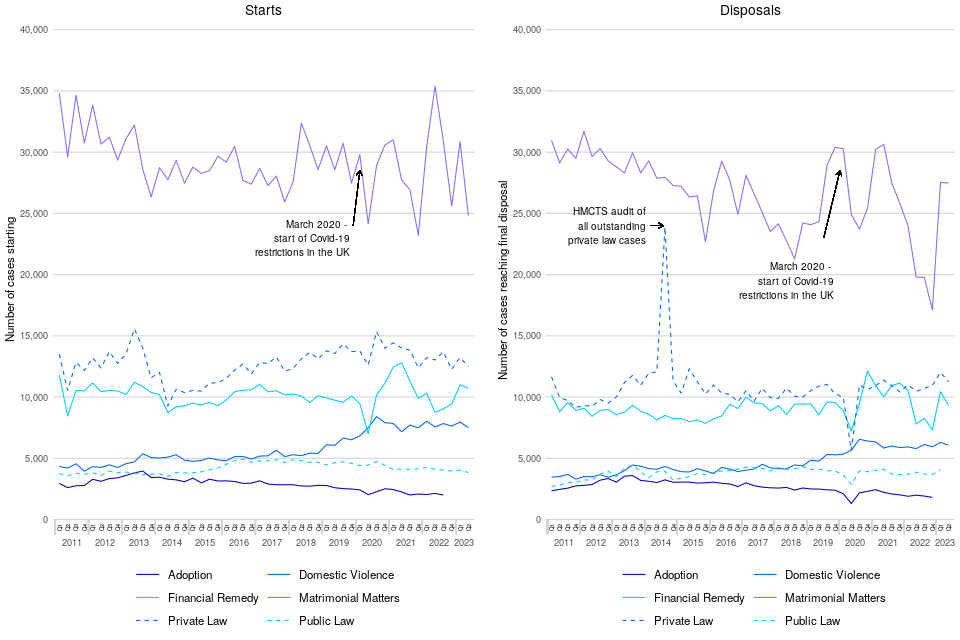
In April to June 2023, 41% of new cases (excluding adoption case starts) within family courts related to matrimonial matters, down from the equivalent quarter of 2022, down from 51% of cases in the equivalent quarter last year when the new divorce law was introduced and cases surged.
There were decreases in most case type starts compared to the equivalent quarter in 2022: matrimonial (30%), public law (6%), private law (4%) and domestic violence cases (0.9%); at the same time there have been increases in financial remedy case starts (22%). In contrast there were increases in most case types reaching a final disposal: matrimonial (39%), financial remedy (19%), private law (7%) and domestic violence (5%) cases. However, there was a decrease in public law (2%) case disposals. (Table 1)
Timeliness by Case Type
The mean average time for divorce and annulment cases to reach first disposal in April to June 2023 was 38 weeks - this includes both old and new divorce cases, with the former covering applications which would have been made some time ago, and the latter incorporating a 20-week wait between application and the conditional order.
Private law cases took longer, with the mean average time to first disposal in April to June 2023 taking 32 weeks, up 2 weeks compared to the same period in 2022.
Public and private law cases – number of parties, and High Court cases
The vast majority of private law cases involve one applicant and one respondent only (Table 6). However, for public law cases whilst nearly all cases have only one applicant, 75% involve two or more respondents.
Private law cases indicated as being a High Court case remained lower than 1%, in line with the long-term trend. In the latest quarter, a smaller proportion of private law cases started were indicated as being a High Court case (0.4%) (Table 7).
HMCTS monthly management information
The statistics in this publication focus on the period between April to June 2023; however, monthly management information (MI) has been published by HMCTS that covers up to July 2023. https://www.gov.uk/government/statistical-data-sets/hmcts-management-information-july-2023. This MI is subject to the data quality issues associated with extracting data from large live administrative case management systems. Late reporting of cases and regular updating of case details, which can lead to the figures being updated to manage the case - more recent figures may therefore be subject to larger revisions and should be treated with greater care and considered provisional.
5. Children Act - Public Law
Decrease in the number of public law case starts
There were 3,843 public law cases starting in April to June 2023, down 6% compared to the equivalent quarter in 2022 (Table 2).
There were 6,363 individual children involved in new public law applications in April to June 2023, down 6% on the same quarter in the previous year, while the number of applications made decreased by 8%. In April to June 2023, public law care applications made up 66% of public law orders applied for (2,902) (Figure 2).
Figure 2: Public law applications by order type, April to June 2023 (Source: Table 3)
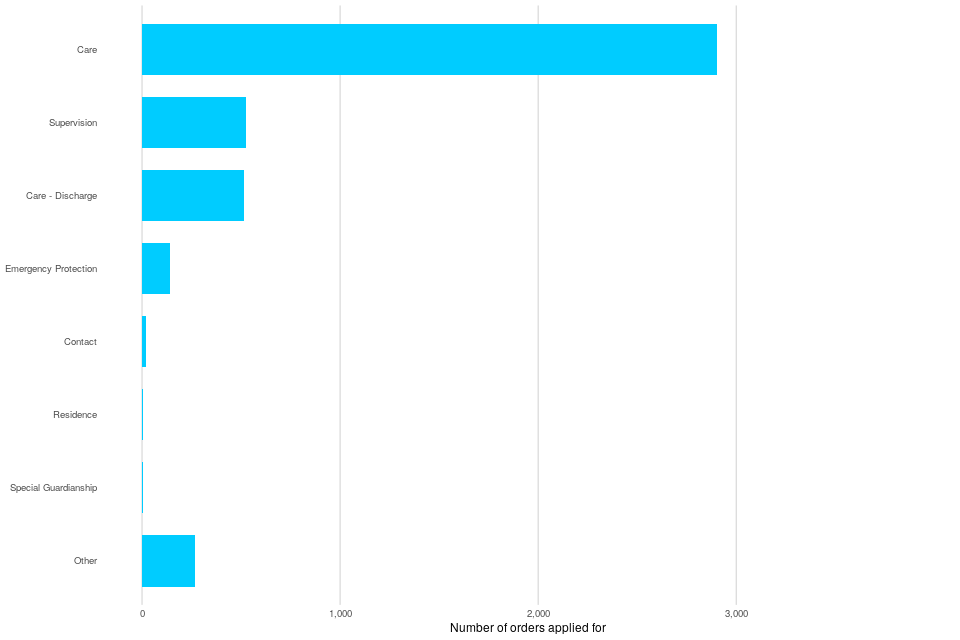
6. Children Act - Private Law
Decrease in the number of private law case starts and increase in the number of cases disposed
The number of private law cases[footnote 1] started decreased by 4% (to 12,497) in April to June 2023 compared to the equivalent quarter in 2022. The number of applications made decreased by 4% over the same period.
The number of private law cases disposed of during April to June 2023 was up 7% on the equivalent quarter in 2022, with the number of disposals down by 2% (Table 2).
There were 13,080 new private law applications made in April to June 2023, down 4% on the equivalent quarter in 2022, with 19,393 individual children involved in these applications.
The number of private law disposals in April to June 2023 was 39,372, down 2% on the equivalent quarter in 2022.
Timeliness of Private law cases
In April to June 2023, it took on average 47 weeks for private law cases to reach a final order, i.e. case closure, up almost 3 weeks from the same period in 2022. This continues the upward trend seen since the middle of 2016, where the number of new cases overtook the number of disposals (Table 9).
Figure 3: Private law timeliness from case start date to final order in the family court, January to March 2011 to April to June 2023 (Source: Table 9)

7. Legal Representation
Cases with legal representation take longer on average
In general, cases where either both parties or the respondent only had legal representation took longer to be disposed of than those cases where only the applicant was represented or where both parties were without legal representation (Table 10).
Legal representation in private law cases
The removal of legal aid for many private law cases in April 2013 resulted in a change in the pattern of legal representation over time[footnote 2],[footnote 3]. In April to June 2023, the proportion of disposals where neither the applicant nor respondent had legal representation was 40%, increasing by 26 percentage points since January to March 2013, and a slight increase from from April to June 2022.
Correspondingly, the proportion of cases where both parties had legal representation went from 41% in January to March 2013 to 19% in April to June 2023, unchanged compared to the same period in 2022 (Figure 4).
Figure 4: Proportion of private law disposals by type of legal representation of the parties, January to March 2012 to April to June 2023 (Source: Table 10)
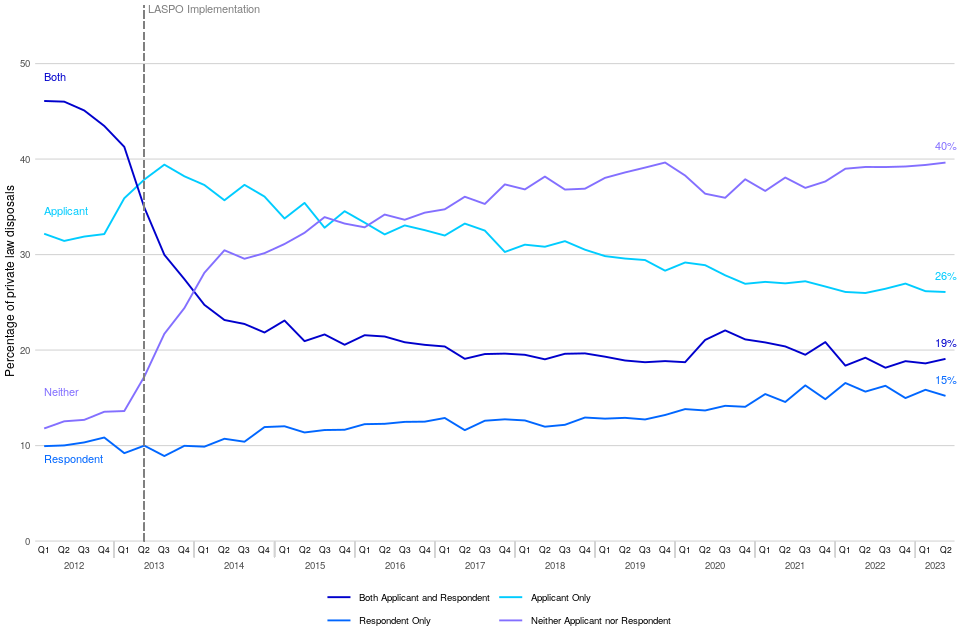
The change seen in the pattern of legal representation is also demonstrated in private law cases with at least one hearing where the proportion of parties with legal representation stood at 59% in 2012 compared to 29% in April to June 2023.
The proportion of parties with legal representation in cases with at least one hearing varies by case type and range from around 77% for public law cases to 3% for adoption cases, with figures subject to change as new cases progress (Table 11).
8. Divorce
There were 24,624 divorce applications made between April to June 2023 under the new legislation
New divorce legislation came into effect from 6th April 2022, which aims to reduce the potential for conflict amongst divorcing couples by:
- removing the ability to make allegations about the conduct of a spouse
- allowing couples to end their marriage jointly.
Please note that the new divorce legislation introduced new terminology and new mandatory waiting periods at key stages. For further information, please see the guide that accompanies this publication.
Between April to June 2023 there were 24,624 applications made (75% from sole applicants, 25% from joint applicants) (Table 12b). This was a decrease of 30% from the same quarter in 2022 where the new divorce law was first intorduced and led to a surge of cases.
There were 27,375 final orders granted in April to June 2023 (20,268 granted under the new divorce law whlist 7,107 decree absolutes/final orders were granted under old divorce law) up 39% compared to the same quarter in 2022 (Table 12)
Increase in the average time for all (old and new) divorce proceedings
In April to June 2023 the mean average time from application to conditional order (90% granted under the new divorce legislation) was 38 weeks up 2 weeks from the same quarter of 2022 (Table 12).
The mean average time from application to final order (74% granted under the new divorce legislation) was 62 weeks, up 6 weeks from the equivalent quarter in 2022.
Please note that, due to the mandatory waiting period between applying for divorce and applying for the conditional order (CO), this means that any new cases started since 6 April 2022 would have had to have waited at least 20 weeks before getting to the CO stage. For cases applied for under the old law, our timeliness measure will be calculating durations for those cases which represent the tail end of cases applied for some time ago, and by definition this measure will be relatively high and will increase over time until all cases applied for under the old law are dealt with.
Digital divorce cases
For digital divorce cases (i.e. those dealt with the Courts and Tribunals Service Centres that are digital at all stages), there were 23,477 applications made during April to June 2023 (95% of the total, down slightly from 96% in the same period of 2022). The average time to conditional order (90% of the total) for April to June 2023 was 31 weeks, and 45 weeks from application to final order (84% of the total).
Sole and Joint divorce cases
There were 18,536 sole applications made during April to June 2023 (75% of the total, down 3% from the same period of 2022). The average time to conditional order for April to June 2023 was 30 weeks, and 38 weeks from application to final order.
There were 6,088 joint applications made during April to June 2023 (25% of the total, up 3% from the same period of 2022). The average time to conditional order for April to June 2023 was 27 weeks, and 36 weeks from application to final order. On average joint cases are quicker than sole cases in reaching conditional and final order.
Figure 5: Divorce applications made between Q2 2022 to Q2 2023, by applicant type (Source: Table 12b)
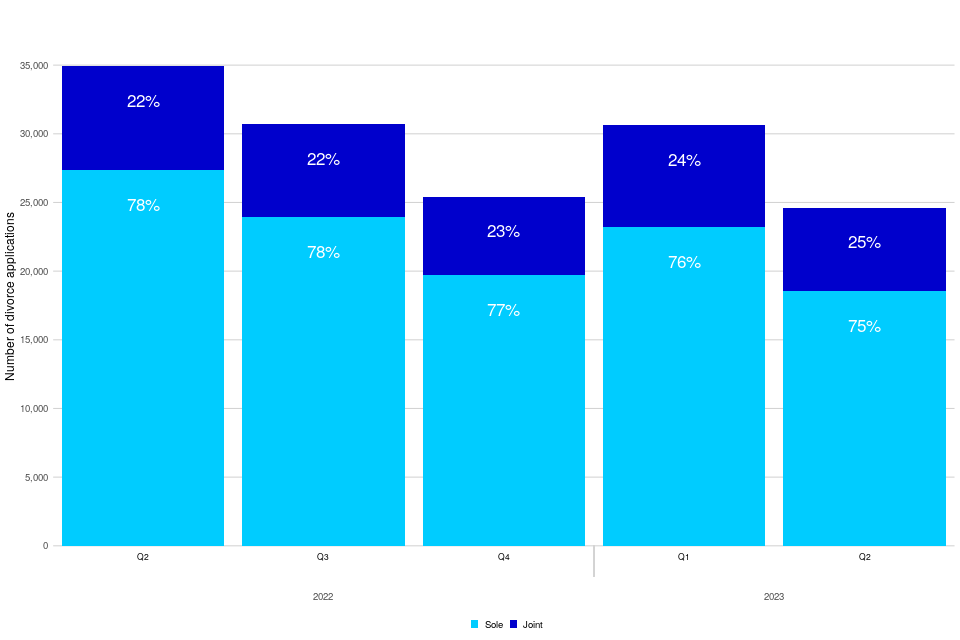
9. Financial Remedy
Increase seen in financial remedy applications and disposals events
In April to June 2023, the number of financial remedy applications was up 20% and the number of disposal events was up 15% compared to the same period in 2022 (Table 14).
There were 11,040 financial remedy applications made in April to June 2023, up 20% from the same period in 2022, while there were 9,546 financial remedy disposals events, up 15%. During this period, 73% of applications were uncontested and 27% were contested.
Figure 6: Applications for financial remedy orders, January to March 2009 to April to June 2023 (Source: Table 14)
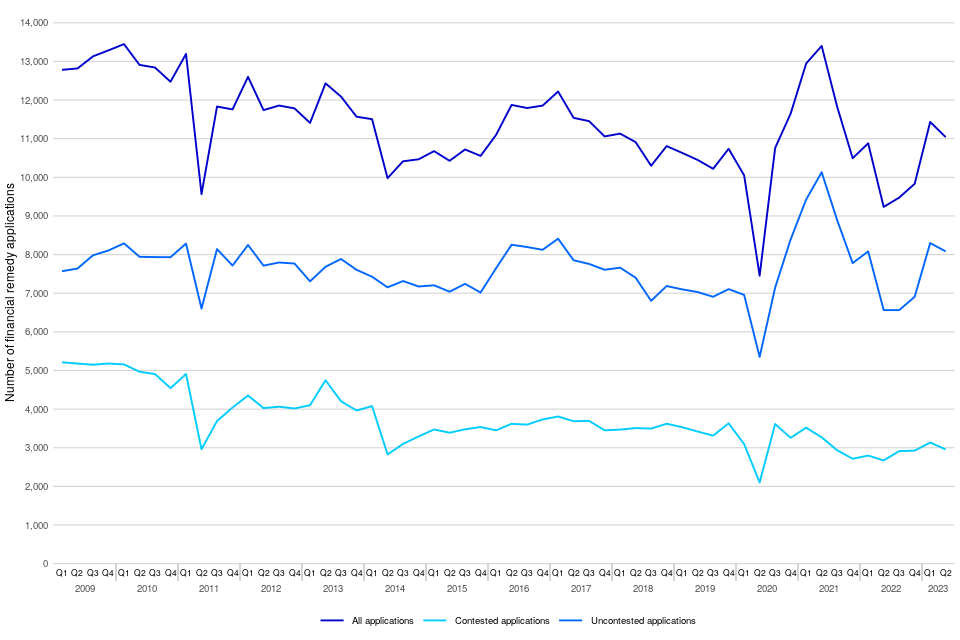
10. Domestic Violence Remedy Orders
Decrease in the number of domestic violence remedy orders, with minimal change in applications made
In April to June 2023, there was a less than 1% increase in applications made compared to the equivalent quarter in 2022. However there has been a longer-term increase in the number of applications, with the number of applications in the latest quarter almost double those made since the series began in 2011. The number of orders made increased 8% over the same period (Table 15).
In April to June 2023, there were 7,812 domestic violence remedy applications, similar to the same quarter in 2022, which resulted in a total of 8,966 orders (multiple orders can be applied for in a single application). Most of the orders applied for were non-molestation orders (84%) compared to occupation orders (16%); these proportions have remained relatively consistent in recent years. Applications for non-molestation orders in April to June 2023 remained at a similar level compared to the same period in 2022, while occupation order applications increased by4%.
There were 8,685 domestic violence orders made in April to June 2023, down 8% from the same period last year. 94% were non-molestation orders and 6% were occupation orders, with non-molestation orders down by 9% and occupation orders up by 4% compared to the equivalent quarter in 2022.
Figure 7: Applications for domestic violence remedy orders, January to March 2009 to April to June 2023 (Source: Table 15)

11. Forced Marriage Protection Orders and Female Genital Mutilation Protection Orders
Long term upward trend in the number of forced marriage protection orders and female genital mutilation protection orders (Table 16 and 17)
The number of applications and orders made for forced marriage protection orders (FMPOs) is very small. Consequently, numbers fluctuate each quarter but overall, there has broadly been a long-term upward trend from their introduction in November 2008 until the end of 2019, with a less pronounced increase thereafter.
In April to June 2023, there were 76 applications. Whilst the number of applications remains similar to the equivalent quarter in 2022, almost all applications were previously for those aged 17 and under. However, in the latest quarter this forms a smaller proportion and of the 76 applications, 74% of these were for people aged 17 and under. Over the same period, there were 112 orders made, up 33% since the same period from the previous year.
An increase in the number of orders does not necessarily represent an increase in the prevalence of forced marriage, but potentially it relates to a greater awareness of forced marriage being a crime and the support available. Particularly during 2019 where the government held events with relevant groups (local authorities, police, charities etc.), designed specifically to raise awareness of FMPOs and how they can be used to protect those at risk. In 2020, health education became compulsory across all state-funded schools in England, where Relationship Education is compulsory in primary schools and Relationship and Sex Education (RES) is compulsory in secondary schools to spread awareness of forced marriages.
Historically the numbers of orders made outweigh the number of applications. Often there are multiple orders granted per case, where one application covers more than one person, and an order is granted for each person covered in the application. Extensions and increased provision of previous orders can also be granted as new orders, without the need for a new application to be submitted.
Figure 8: Applications and orders made for Forced Marriage Protection Orders, January to March 2009 to April to June 2023 (Source: Table 16)

As with FMPOs, the number of applications and orders made for female genital mutilation protection orders (FGMPOs) is very small, with only 6 applications and 7 orders made in April to June 2023 respectively (Table 17). In total, there have been 593 applications and 847 orders up to end of June 2023, since their introduction in July 2015.
12. Adoptions
Increase in the number of adoption applications and orders, despite the longer-term trend showing a fall in adoptions
During April to June 2023, there were 1,019 adoption applications made, up 3% from the equivalent quarter in 2022. Over the same period, the number of adoption orders issued also increased by 3% to 1,025 (Tables 18 and 19).
There were 1,974 total disposals in April to June 2023, a decrease of 2% compared to the equivalent quarter in 2022.
The chart below shows the trend of adoption orders by the type of adopter. This shows that during April to June 2023, 56% of all adoption orders were issued to mixed-sex couples, 19% to sole applicants, 17% to same-sex couples and 7% to step-parents.
Figure 9: Adoption orders issued, by adopter, January to March 2011 to April to June 2023 (Source: Table 19)
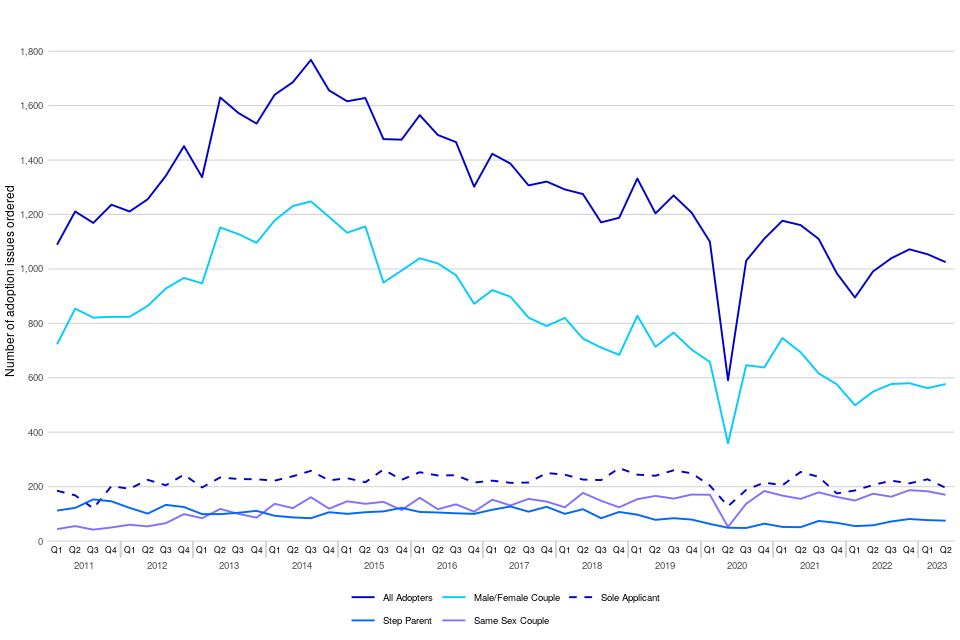
13. Mental Capacity Act - Court of Protection
Decrease in applications with an increase in orders made in relation to deprivation of liberty
There were 1,432 applications relating to deprivation of liberty made in the most recent quarter, which is a decrease of 2% on the number made in the same quarter in 2022. However, there was an increase by 162% in the orders made for deprivation of liberty over the same period from 648 to 1,698.
A decrease in applications whilst orders increase under the Mental Capacity Act 2005 (MCA)
There were 7,746 applications made in April to June 2023, down by 9%. During the same period there were 16,349 orders made, up by 45% - the highest quarterly volume for orders since the start of the series.
Since the Supreme Court clarified the definition of deprivation of liberty in 2014, there has been a significant increase in the number of applications. There were 15 applications in January to March 2013 which increased to a high of 1,744 in July to September 2020. There were 1,432 applications in April to June 2023. Deprivation of liberty orders made saw an increase by 162% from 648 last year to 1698 in the latest quarter, much higher than in previous quarters due to efforts by courts to increase the number of orders made.
Figure 10: Deprivation of Liberty applications and orders, January to March 2011 to April to June 2023 (Source: Table 21)
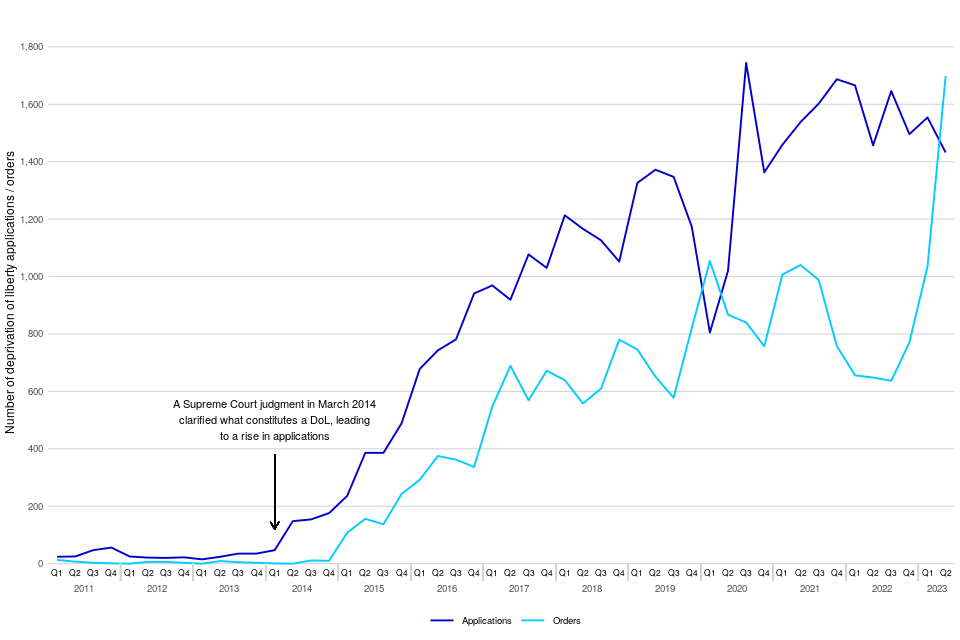
In April to June 2023, there were 7,746 applications made under the Mental Capacity Act 2005 (MCA), down by 9% on the equivalent quarter in 2022 (8,498 applications). Of those, 30% related to applications for appointment of a property and affairs deputy (Table 20).
In comparison, due to efforts by the court to increase orders made, there were 16,349 orders made under the Mental Capacity Act 2005 (MCA), up by 45% on the same quarter in 2022. Of those, 39% related to orders by an existing deputy or registered attorney (Table 21).
14. Mental Capacity Act - Office of the Public Guardian
Continuing increasing trend in Lasting Powers of Attorney (LPAs)
In April to June 2023, there were 275,569 LPAs registered, the highest in its series and up 43% compared to the equivalent quarter in 2022 (Table 22).
In total there were 277,399 Powers of Attorney (POAs) registered in April to June 2023, up 43% from the same quarter in 2022 and the highest in the series (Table 22). In April to June 2023, 57% of POAs registered were from female donors whilst 42% were from male donors and 53% were over 75 years old. Lasting Power of Attorney (LPAs) made up 99% of POAs registered in April to June 2023, with Enduring Powers of Attorney (EPAs) making up the other 1%. There were 1,830 EPAs registered in April to June 2023, similar to the equivalent quarter in 2022.
The sharp increase in LPAs seen during 2015 and 2016 was largely due to increased publicity and the new online forms introduced in July 2015 making it simpler and faster to apply.
Figure 11: Powers of Attorney registered, January to March 2008 to April to June 2023 (Source: Table 22)

15. Probate Service
Large increase in time taken for probate grants to be issued
Probate grants took approximately 14 weeks to be issued after the application was submitted during April to June 2023. Letters of administration with a will and without a will took around 23 and 18 weeks respectively (Table 24).
Similar levels in the proportion of probate grants issued made digitally with an increase in the proportion of digital applications for probate grants
In April to June 2023, there were 62,220 applications for probate grants. 49,647 probate grants were issued in the same period. 89% of these applications and 88% of these grants issued were made digitally, compared to 87% and 88% respectively in the same quarter in 2022 (Table 23).
There were 74,813 applications made for grants of representation in April to June 2023. 62,220 (83%) of these were for probate grants, of which 89% were made digitally (Table 23).
Probate grants also make up the majority (80%) of all grants issued. In April to June 2023, 49% of the grants issued were applied for by legal professionals and 51% were personal applications (Table 23). For the 49,647 probate grants issued in the same period, 88% were issued digitally.
Timeliness of probate grants
The mean average time from application submission to grant issue for probate grants was 14 weeks (median average 11 weeks) overall. The mean time between application submission and grant being issued is the highest it’s been since 2019 and represents recent work to focus on the oldest cases. The mean average time for the majority of grants (digital probate grants for applications not stopped which formed 62% of total probate grants issued) took approximately 9.5 weeks from application submission to grant issue (up from 4 weeks compared to the equivalent quarter of 2022) and document receipt to grant issue was 6.8 weeks (up from 1.8 weeks compared to the equivalent quarter of 2022).
Timeliness of grants issued can be affected if the case has been ‘stopped’ for any reason (which can occur when there’s a dispute about either who can apply for probate or issues with a will or proposed will, or if an error is identified and a request for further information is made). Probate grants that were stopped during April to June 2023 took 22 weeks on average to be issued, compared to 10 weeks for those that were not stopped.
When looking at the time from document receipt (i.e. when payment has been made and the application and all accompanying documents are ready for examination) to grant issue, this is around 2 weeks quicker than the average time from application submission for probate grants.
Averages for letters of administration with a will and without a will were 23 and 18 weeks respectively for April to June 2023, though these formed a smaller proportion of all grants issued, 4% and 15% respectively (Figure 12).
Figure 12: Average (mean) time for grants of representation issued from application submission by the Probate Service, July to September 2019 to April to June 2023 (Source: Table 24)
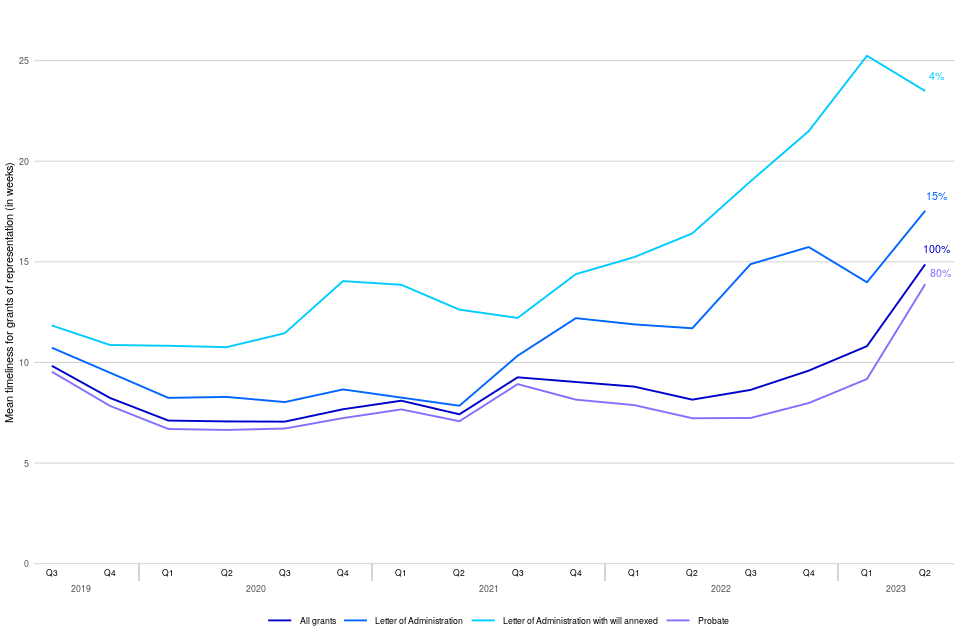
16. Further information
The data presented in this publication are extracted from live administrative databases. Therefore, previously published data is liable to be updated in the latest bulletin, following any further data cleaning or the incorporation of additional cases not available in the extracts used to produce previous bulletins.
Accompanying files
As well as this bulletin, the following products are published as part of this release:
-
A technical guide providing further information on how the data is collected and processed, as well as information on the revisions policy and legislation relevant to family court and background on the functioning of the family justice system
-
A set of overview tables and CSV files, covering each section of this bulletin
National Statistics status
National Statistics status means that official statistics meet the highest standards of trustworthiness, quality and public value.
All official statistics should comply with all aspects of the Code of Practice for Official Statistics. They are awarded National Statistics status following an assessment by the Authority’s regulatory arm. The Authority considers whether the statistics meet the highest standards of Code compliance, including the value they add to public decisions and debate.
It is the Ministry of Justice’s responsibility to maintain compliance with the standards expected for National Statistics. If we become concerned about whether these statistics are still meeting the appropriate standards, we will discuss any concerns with the Authority promptly. National Statistics status can be removed at any point when the highest standards are not maintained, and reinstated when standards are restored.
Contact
Press enquiries should be directed to the Ministry of Justice press office:
Tel: 0203 334 3536
Other enquiries about these statistics should be directed to:
Carly Gray, Head of Access to Justice Data and Statistics, using the following email address familycourt.statistics@justice.gov.uk
Next update: 21 December 2023
URL: https://www.gov.uk/government/collections/family-court-statistics-quarterly
© Crown copyright
Produced by the Ministry of Justice
Alternative formats are available on request from familycourt.statistics@justice.gov.uk
-
The Children and Family Court Advisory and Support Service (Cafcass) also publishes (England only) data on the number of private law cases. A comparison of Cafcass and MoJ data and further information can be found in the accompanying guide. ↩
-
Please see the accompanying guide for further details. ↩
-
Removal of Legal Aid was a result of the Legal Aid, Sentencing & Punishment of Offenders Act 2012 (LASPO). ↩
